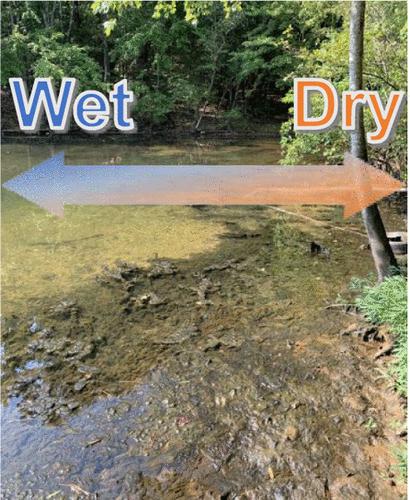当前位置:
X-MOL 学术
›
Environ. Sci. Technol.
›
论文详情
Our official English website, www.x-mol.net, welcomes your feedback! (Note: you will need to create a separate account there.)
Shoreline Drying of Microseira (Lyngbya) wollei Biomass Can Lead to the Release and Formation of Toxic Saxitoxin Analogues to the Water Column
Environmental Science & Technology ( IF 11.4 ) Pub Date : 2022-11-18 , DOI: 10.1021/acs.est.2c05579 Tryston T Metz 1, 2 , Samuel P Putnam 1, 2 , Geoffrey I Scott 2, 3 , John L Ferry 1, 2
Environmental Science & Technology ( IF 11.4 ) Pub Date : 2022-11-18 , DOI: 10.1021/acs.est.2c05579 Tryston T Metz 1, 2 , Samuel P Putnam 1, 2 , Geoffrey I Scott 2, 3 , John L Ferry 1, 2
Affiliation

|
The harmful, filamentous cyanobacteria Microseira (Lyngbya) wollei produces several toxic analogues of saxitoxin (Lyngbya wollei toxins 1–6, or LWTs 1–6), grows in shallow water, and can deposit significant biomass on nearby shorelines. Here, we show that the LWTs are stable in the biomass during subsequent drying but that the process facilitates the later release of LWTs upon return to the water column. Under basic conditions, LWTs hydrolyzed to generate products that were significantly more neurotoxic than the initial toxins. Aqueous LWTs were subjected to conditions of covarying temperature and pH, and their degradation rates and products were determined at each condition. LWTs 1, 5, and 6 degraded faster at pH ≥ 8 at all temperatures. Their degradation products, which included decarbamoyl saxitoxin and LWT 4, were consistent with a base-catalyzed hydrolysis mechanism and represented a net increase in total biomass toxicity normalized against the equivalent toxicity of saxitoxin. The corresponding pre-exponential terms and activation energies for hydrolysis were obtained for pH 6–10 over the temperature range 10–40 °C. A locally weighted scatterplot smoothing (LOWESS) regression was developed to predict the loss of parent toxins and subsequent products in the water column under conditions corresponding to those commonly encountered in cyanobacterial blooms.
中文翻译:

Microseira (Lyngbya) wollei 生物质的海岸线干燥会导致有毒石房蛤毒素类似物向水体中的释放和形成
有害的丝状蓝藻Microseira (Lyngbya) wollei产生几种有毒的石房蛤毒素类似物 ( Lyngbya wollei毒素 1-6,或 LWTs 1-6),生长在浅水中,可以在附近的海岸线上沉积大量生物量。在这里,我们表明 LWT 在随后的干燥过程中在生物质中是稳定的,但该过程有助于 LWT 在返回水柱后的后期释放。在基本条件下,LWT 水解生成比初始毒素具有更大神经毒性的产物。将水性 LWT 置于温度和 pH 值共变的条件下,并在每种条件下测定它们的降解率和产物。LWT 1、5 和 6 在所有温度下 pH ≥ 8 时降解更快。它们的降解产物,包括 decarbamoyl 石房蛤毒素和 LWT 4,与碱催化的水解机制一致,并代表相对于石房蛤毒素的等效毒性归一化的总生物量毒性的净增加。在 10-40 °C 的温度范围内,pH 6-10 获得了相应的水解指数前项和活化能。开发了局部加权散点图平滑 (LOWESS) 回归,以预测在与蓝藻水华中常见的条件相对应的条件下,水柱中母体毒素和后续产物的损失。
更新日期:2022-11-18
中文翻译:

Microseira (Lyngbya) wollei 生物质的海岸线干燥会导致有毒石房蛤毒素类似物向水体中的释放和形成
有害的丝状蓝藻Microseira (Lyngbya) wollei产生几种有毒的石房蛤毒素类似物 ( Lyngbya wollei毒素 1-6,或 LWTs 1-6),生长在浅水中,可以在附近的海岸线上沉积大量生物量。在这里,我们表明 LWT 在随后的干燥过程中在生物质中是稳定的,但该过程有助于 LWT 在返回水柱后的后期释放。在基本条件下,LWT 水解生成比初始毒素具有更大神经毒性的产物。将水性 LWT 置于温度和 pH 值共变的条件下,并在每种条件下测定它们的降解率和产物。LWT 1、5 和 6 在所有温度下 pH ≥ 8 时降解更快。它们的降解产物,包括 decarbamoyl 石房蛤毒素和 LWT 4,与碱催化的水解机制一致,并代表相对于石房蛤毒素的等效毒性归一化的总生物量毒性的净增加。在 10-40 °C 的温度范围内,pH 6-10 获得了相应的水解指数前项和活化能。开发了局部加权散点图平滑 (LOWESS) 回归,以预测在与蓝藻水华中常见的条件相对应的条件下,水柱中母体毒素和后续产物的损失。


























 京公网安备 11010802027423号
京公网安备 11010802027423号